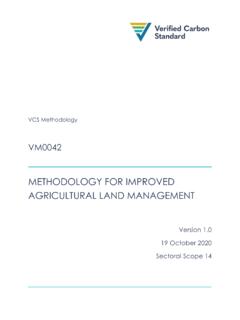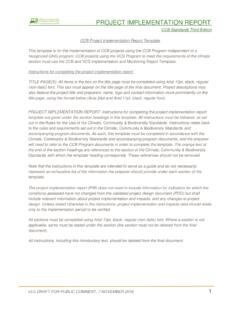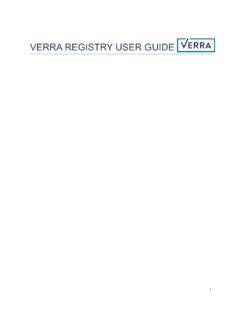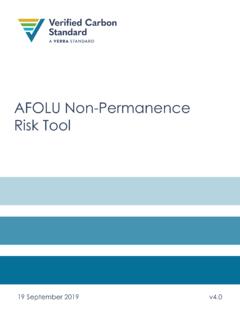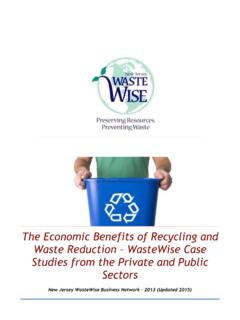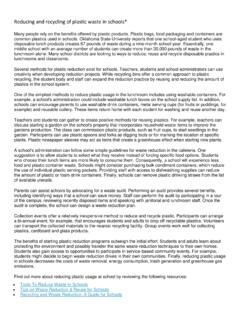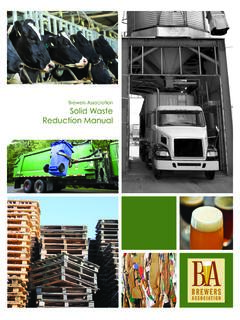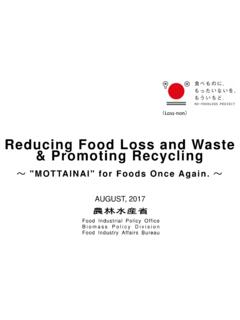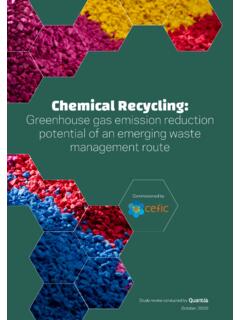Transcription of Plastic Waste Recycling Methodology - Verra
1 1 Plastic Waste Recycling Methodology Version 7 October 2020 CONTENTS 1 SOURCES .. 2 2 SUMMARY DESCRIPTION OF THE Methodology .. 2 3 DEFINITIONS .. 3 4 APPLICABILITY CONDITIONS .. 6 This Methodology is applicable under the following conditions: .. 6 This Methodology is not applicable under the following conditions: .. 8 5 PROJECT BOUNDARY .. 9 6 BASELINE SCENARIO .. 10 7 DEMONSTRATION OF ADDITIONALITY .. 10 Step 1: Regulatory Surplus .. 11 Step 2: Project Scale and Positive List .. 12 Step 3: Penetration Rate of Recycling Activities .. 15 Step 4: Investment and Non-Compete Analysis .. 17 8 QUANTIFICATION OF Plastic Waste Recycling .. 21 Baseline Recycling .. 22 Project Recycling .. 24 Eligible Plastic Waste Recycling in the Region.
2 25 Net Recycled Plastic Waste .. 25 9 MONITORING .. 26 Data and Parameters Available at Validation .. 26 Data and Parameters Monitored .. 28 Description of the Monitoring Plan .. 31 2 1 SOURCES 1 The approaches for demonstrating the baseline and additionality have been developed based on 2 the following methodologies: 3 CDM tool: Combined tool to identify the baseline scenario and demonstrate additionality, 4 2017, version 5 CDM tool: Tool for the demonstration and assessment of additionality, 2012, version 6 CDM tool: Demonstration of additionality of small-scale project activities, 2019, version 7 CDM tool: Investment analysis, 2019, version 8 CDM Methodology : Recovery and Recycling of materials from solid wastes, 9 2018, version 10 CDM Methodology : AMS-III-BA.
3 Recovery and Recycling of materials from E- Waste , 2018, 11 version 12 EUCertPlast Audit Scheme (Version ) 13 The following have also informed the development of this Methodology : 14 IPCC, Chapter 3, Solid Waste Disposal - 2019 Refinement to the 2006 IPCC Guidelines for 15 Natural Greenhouse Gas Inventories. 16 ISO 14040:2006 (E) - Environmental management - Life cycle assessment - Principles and 17 Framework 18 ISO 14064-2:2006 (E) (clause 4) - Greenhouse Gases - Part 2: Specification with guidance 19 at the project level for quantification, monitoring and reporting of greenhouse gas emission 20 reductions or removal enhancements 21 ISO 15270:2008 (en) - Plastics - Guidelines for the recovery and Recycling of plastics Waste 22 - Terms and Definitions for Textile Exchange Standards and 23 Related Documents 24 2 SUMMARY DESCRIPTION OF THE Methodology 25 Additionality and Crediting Method Additionality Activity and project method Crediting Baseline Project method 3 This Methodology provides procedures to estimate the net Plastic waste1 recycled through 1 mechanical Recycling activities, including the installation of new Recycling facilities, capacity 2 additions or technology improvement to existing Recycling facilities, Recycling of material types 3 (including packaging)
4 That have not previously been recycled at an existing facility, and 4 incentivizing or facilitating an increase in the collection of Plastic Waste . 5 Recycling activities may include sorting and/or processing of Plastic Waste material ( , 6 production of recycled material) that otherwise would have been managed in a way that would not 7 allow for a second life of the material. 8 Projects that include both collection and Recycling activities shall apply this Methodology in 9 conjunction with the Plastic Waste Collection Methodology to demonstrate additionality and 10 quantify the Plastic Waste collected and recycled by the respective activities. 11 Sections that are not applicable to projects using the Plastic Standard only to account for the 12 results of their Recycling activities and not to issue Waste Recycling Credits are marked as such2.
5 13 3 DEFINITIONS 14 In addition to the definitions set out in the Plastic Waste reduction Program ( Plastic Program) 15 document Plastic Program Definitions, the following definitions apply to this Methodology : 16 Capacity addition: An investment to increase the capacity of an existing Recycling facility 17 through the addition of new equipment, replacement of existing equipment, modification of 18 existing equipment and/or modification of the process 19 Collected material: Plastics material that has been removed from the environment or 20 recovered, separated, diverted or removed from the solid- Waste stream in order to ensure 21 suitable end-of-life, such as managed landfill, Recycling or incineration with energy recovery 22 (adapted from ISO 15270:2008 (en) - Plastics - Guidelines for the recovery and Recycling of 23 plastics Waste ).
6 This can include post-consumer and post-industrial material. 24 Collection area: The geographical area from which Plastic Waste is collected, including 25 populated areas ( , landfill, Waste aggregation center, sorting center) or more dispersed 26 sources of Waste ( , households, businesses). In this Methodology , where Plastic Waste 27 is collected from a landfill, Waste aggregation or sorting centers, or other geographical 28 areas outside the project boundary ( , imported Plastic Waste ), the collection area should 29 include the geographical areas where the Waste was originally sourced to determine the 30 population density in that area. 31 Contaminant: Unwanted substance or material. Contaminants may include, but are not 32 limited to, liquids, organic matter, other Plastic types and materials.
7 33 1 In this document, the term Plastic Waste refers to all Waste that includes materials under the scope of the Plastic Program, including composite materials ( , used beverage cartons). 2 In this Plastic Waste Recycling Methodology , this is Section 7. 4 End-products: The physical goods that result from the product manufacturing process. 1 Note that final products can be made from virgin (including both fossil and bio-based) or 2 recycled material, or a combination of both. 3 Energy recovery: The production of useful energy through direct and controlled 4 combustion (ISO 15270:2008 (en) - Plastics - Guidelines for the recovery and Recycling of 5 plastics Waste ) 6 Input: Product, material or energy flow that enters a unit process (ISO 14040:2006 (E) - 7 Environmental management - Life cycle assessment - Principles and Framework) 8 Managed landfill: A Waste disposal site for the deposit of Waste onto or into land under 9 controlled or regulated conditions (ISO 15270:2008 (en) - Plastics - Guidelines for the 10 recovery and Recycling of plastics Waste ).
8 Waste that is disposed of at the managed landfill 11 is unlikely to leak into the environment over time. The landfill shall: 12 o Be government recognized or affiliated; 13 o Have restrictions on access to avoid Waste scavenging; 14 o Have a well-defined boundary; 15 o Include at least one of the following: cover material; mechanical compacting, or 16 leveling of the Waste (IPCC, 2019); 17 o Have daily cover application (with soil or other material) to remove Plastic Waste 18 from the influence of the outside environment; 19 o Have a leachate drainage system (IPCC, 2019) or other reasonable measures to 20 avoid soil and water contamination; 21 o Include sanitary lining or other reasonable measures to avoid Waste being placed 22 directly on the ground; 23 o Be capped when it closes.
9 24 o Control placement of Waste ( , to specific areas in the landfill) (IPCC, 2019); and 25 o Have measures to avoid fires ( , to avoid open burning) (IPCC, 2019). 26 Note to Reviewers: The definition of managed landfill has been developed using established definitions, while being sensitive to the variation in local conditions that affect the quality of accessible landfills, to avoid excluding projects that collect Plastic in more remote areas. 27 1. Question for consideration: Is the definition of managed landfill appropriate? Should projects have to meet all of the above requirements, or are there top requirements that should be included in a subset of priority requirements? 5 1 Material concentration: A stage in the Recycling process that occurs after collection and 2 may include one or more of the following activities: sorting, screening, basic contaminant 3 removal and baling.
10 Material is still unprocessed at this stage, meaning it has not been 4 physically or chemically altered beyond basic handling ( , screening, crushing, or 5 washing). 6 Note to Reviewers: We included a definition of material concentration because it aligns closely with the intended use of sorting under the Plastic Program, and may help to align existing Recycling terminology to the Plastic Program. Open burning of waste3: Uncontrolled Waste combustion practices, including dump fires, 7 pit burning, fires on plain soil and barrel burning. Open burning is characterized by burning 8 at low temperatures (between 250 C and 700 C) and in oxygen-deprived environments 9 leading to incomplete combustion of Waste . It also refers to burning conducted in such a 10 manner that combustion air is not effectively controlled and combustion products are not 11 vented through a stack or chimney.


